Leotax Cameras 1947-1961
A Description of Leotax Cameras 1947-1961
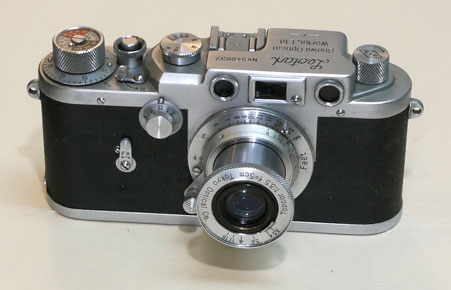
A Leotax F of 1954 labeled "Showa Optical Works, Ltd." with the Topcor 5cm f3.5 lens
History of Leotax Cameras
The company which was to become Leotax was started by Nakagawa Kenzō (中川幹三) a former engineer of K.K. Konishiroku (later Konica). He named his company or shop at the beginning of 1938 as Kyōei-sha and later that year, renamed to G.K. Shōwa Kōgaku - ㈾昭和光学 - Shōwa being reference to the reign of the current Emperor Hirohito.
After development of other cameras not part of this article, by 1940 they had developed a camera somewhat resembling a Leica III or Leica II, but with an uncoupled rangefinder not linked to the lens. This is often referred to as the Leotax 'Original'.
Leotax 'Original'
Shōwa Kōgaku in 1940 made a small number of hand-produced 35mm cameras having a resemblance to a Leica II, but with an uncoupled rangefinder positioned to the (photographer's) left of the viewfinder. 1940 was the last year in which many Japanese cameras produced were sold to the public. Starting in 1942 the government directed that no cameras would be sold to anyone expect the military and selected journalists.
In this new Shōwa Kōgaku camera, the rangefinder, manufactured by Nihon Kosokki Kogyo 5 was uncoupled and operated by a focusing wheel on the camera top. From photographs, the rangefinder base seems only about 18mm. The shutter speed dial was calibrated Z, 20, 30, 60, 100, 200, 500.
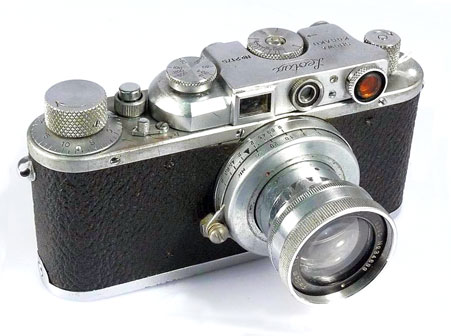
one of the few surviving Leotax 'Original' cameras manufactured 1940 or 1941
Hans P. Rajner in his excellent work Leica Copies 5 estimates "about 50" as the production, but from the serial numbers of the few surviving examples, the production may have exceeded one hundred.
Leotax Special A and Leotax Special B
Shōwa Kōgaku continued to produce cameras for the Japanese military in 1942, and perhaps 1943.
The Leotax Special A was similar to the Leica II, being without slow shutter speeds. The shutter speed dial was calibrated Z, 20, 30, 60, 100, 200, 500. Hans P. Rajner 5 estimates that about 150 of these Leotax Special A cameras were assembled with serial numbers in the range of 20xx.

Leotax Special A camera top with 2096 body number
Hans P. Rajner 5 estimates that about 150 of these Leotax Special A cameras were assembled with serial numbers in the range of 20xx. The camera was delivered with a Letana Anastigmat 5cm f3.5 lens as shown in the photograph above.
Leotax Special B
The Leotax Special B was also assembled in 1942 and perhaps 1943. It was a reasonably close copy of the Leica III and had a slow shutter speeds on a camera front dial in the conventional way. Slow speeds were 1, 2, 4, 8, 20. The Special B had separate rangefinder and viewfinders with a 27mm base for the rangefinder. Hans P. Rajner 5 estimates the production to have been 'about 100' units, with serial numbers 20xx to 23xx.

A Leotax Special B body number 2208
The Leotax Special B was delivered with a Letana Anastigmat 5cm f3.5 lens, as shown above, or with a Tokyo Kogaku 5cm f3.5, something like the lens illustrated below.
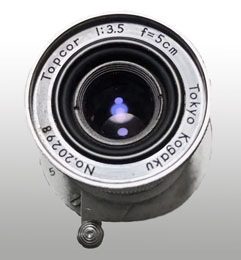
The Leotax Special
Post-war, the company was renamed Shōwa Kōgaku Seiki K.K. - 昭和光学精機㈱ - and resumed 35mm camera production in 1946. The first product was called the "Leotax Special" and had features nearly identical to the Leotax Special A. It had no slow speeds, and the viewfinder, rangefinder arrangement was the same as the Special A and Special B. It could have been assembled, in part, from components left over from Leotax Special A and Special B war-time manufacture.
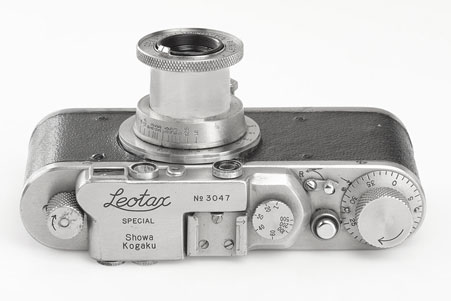
Leotax Special with body number 3047
Unlike the Leotax Special A and Special B, which had lugs for connection of a neck strap, the 1946 Leotax Special had no lugs an needed to reside in its leather case to benefit from a neck strap. Hans P. Rajner 5 estimates the production to have been 600-700 units, with serial numbers 26xx to 32xx.
The Leotax Special D II and Special D III
In 1947, Shōwa Kōgaku introduced two new models: the Leotax Special D II and Special D III. 24 These two were similar, with the Special DII without slow shutter speeds, and the Special D III including slow speeds. These models very close in appearance to the Leica II and Leica III, with a newly designed rangefinder and viewfinder. The finders continued to be separate, but were arranged with the viewfinder windows on either side of a central viewfinder, as with the Leicas.
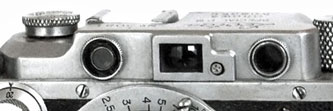
The new viewfinder/rangefinder of the Leotax Model D II and Leotax Model D III of 1947
With the separation of the rangefinder windows, the focusing base of these Leotax cameras was increased to 39mm.
The Leotax Model D II -1947

Leotax Model D II of 1947 serial 3830
Following World War II, Japanese camera production was slow to return to volume due to the distruction of components, the collapse of distribution, and the dislocation of skilled workers.
| Year | Quantity Produced 20 |
|---|---|
| 1944 | 29,548 |
| 1945 | 13,082 |
| 1946 | 24,145 |
| 1947 | 51,772 |
In 1947, Shōwa Kōgaku aggressively resumed production and sold many cameras to the group having the most disposible money: the military troups then occupying Japan. The Leotax Model DII was popular in the Allied military Post Exchange stores. Consequently, the Leotax Model D II has been most easily found taken home to the US, although still rare. The Model D II was produced in about 300 to 400 units with serial numbers 34xx to 38xx. 5
The Leotax Model D III
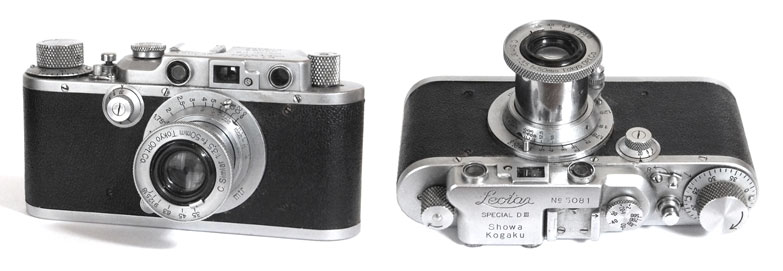
Leotax Model D III of 1947 with Tokyo Optical Simlar 50mm f3.5 lens
The Leotax Model DIII, introduced by Shōwa Kōgaku in April, 1947 24, was a direct copy of the Leica III. Shutter speeds were split at 1/20 second and the high speed progression was Z, 20-1, 30, 40, 60, 100, 200, 500. The slow shutter dial, with a progression of 1, 2, 4, 8, 20 had a center screw, and did not have a dial lock.
The Leotax Model DIII was produced in about 1,000 to 1,500 units with serial numbers 37xx to 59xx. 5
The Leotax Model D IV
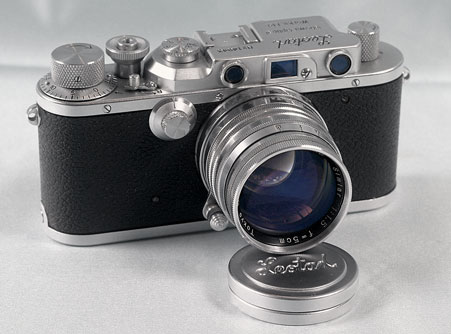
A Leotax Model D IV of 1951 labeled "Showa Optical Works Co. Ltd." with the Simlar 5cm f1.5 lens
The Leotax Model D IV was Shōwa Kōgaku's first camera labeled "Showa Optical Works Co. Ltd.", rather then "Showa Kogaku". The stylized "Leotax" logo on the camera top was simplified, although (to my eyes) less attractive. The company introduced the Leotax Model D IV in January, 1950 24.
The Leotax Model D IV had several improvements over previous models:
- it had a raised and strengthened top frame
- neck strap lugs were added; previously it was necessary to use the camera case for neck straps
- it had a large protective ring around the shutter release
The shutter was configured with the older progression of 1 to 20 on the slow speed dial (without dial lock) and without the dial center screw. The high speed progression was B, 20-1, 30, 40, 60, 100, 200, 500. The rangefinder and viewfinder continued separate, with the 39mm rangefinder base, as with the contemporary Leica.

The Leotax D IV was sold 1950 to 1952 and during that time about 2500 units were produced with a serial number range of 12xxx to 15xxx. 5
1954: Shōwa Optical Works, Ltd. introduces the Leotax Model F
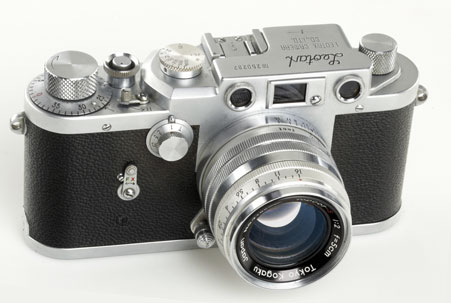
A Leotax F of about 1957 labeled "Leotax Camera Co. Ltd." with the Topcor 5cm f2.0 lens
Shōwa Kōgaku introded the Leotax Model F in June 1954. It was a major upgrade in the Leotax camera features.
- it was the first Leotax with flash synchronization. This was for both flash bulbs and for electronic strobe flash via a coaxial connector on the camera back.
- it had an improved shutter mechanism split at 1/25 second with high speeds extended to 1/1000 second
- the slow shutter speed, with a shutter dial lock, split at 1/25 second and the slow shutter progression was T, 1, 2, 5, 10, 15, 25.
- the fast speed now extended to 1/1000 second, with high speed progression of B, 25-1, 35, 50, 75, 100, 200, 500, and the new 1000.
- A film reminder was added to the film winding knob
- it had a new strengthened full one-piece metal superstructure which extended around the lens
The Leotax F was produced 1954 to 1956, with camera serial numbers 540xxx to 552xxx. The cameras during this period were labeled "Showa Optical Works" on the top cover. Later production in 1957 and 1958 was labeled with "Leotax Camera Co. Ltd." The rangefinder/viewfinder was combined.
The Model F was flash synchronized via a coaxial connector on the camera back. The lever on the camera front, shown in the photograph above, at first appears to be a self-timer, but is in fact the switch for selecting between "F" for flash bulbs and "X" for electronic strobe.
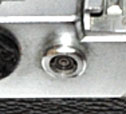
The Model F sold well during during its 3 years selling 5,000 to 6,000 cameras, with serial numbers in the range 540xxx to 552xxx for the "Showa Optical Works" version and in the range 250xxx to about 26xxxx with some overlap with the Leotax T and Leotax K. 5
Shōwa Optical Works, Ltd. introduces the Leotax T

A Leotax Model T of 1955 with the Tokyo Optical Simlar 5cm f3.5 lens
In December 1955, Shōwa Optical Works introduced the Leotax T, which was essentially a lower priced Model F. It had the new strengthened full one-piece metal superstructure which extended around the lens and the improved shutter with speeds split at 1/25 second. The top speed of 1/1000 second was suppressed, likely a marketing decision, since the shutter mechanism was the same as the Model F. The slow shutter dial had the added dial lock, and its progression was the new T, 1, 2, 5, 10, 15, 25. High speed progression was B, 25-1, 35, 50, 75, 100, 200, 500, lacking the 1/1000 top speed of the Leotax F.
The Leotax T similarly had flash bulb and electronic strobed flash synchronization selected on the camera front. The Model T as an economy version was sold with the Tokyo Optical Simlar 5cm f3.5 as shown in the photograph above. The camera was also sold with the high speed Tokyo Optical Simlar 50mm f1.5 lens. 24 You can see the Simlar 50mm f1.5 lens in the Leotax D IV photograph above.

A Leotax Model T of 1958 labeled "Leotax Camera Company, Ltd."
The early production Leotax T, shown in the upper photo, was engraved "Showa Optical Works, Ltd." Later production in 1957-1958, shown in the lower photo, was labeled "Leotax Camera Company, Ltd." Total production December 1955 to the end of 1958 was about 4,000 to 5,000 units in serial numbers 546xxx to 555xxx for the "Showa Optical Works, Ltd." version, and 250xxx to about 26xxxx with some overlap with the Leotax F and Leotax K.
The Leotax Model K
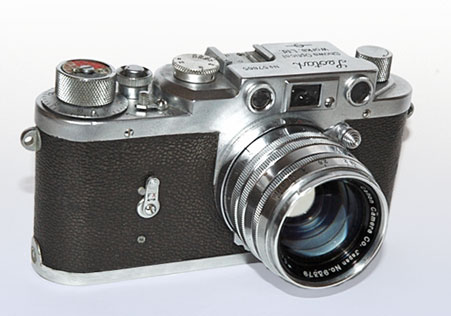
A Leotax Model K of about 1956 fitted with a Canon 50mm lens
Shōwa Kōgaku introduced the Leotax Model K in 1955. It was the lowest priced of the Models F, T and K primarily by de-featuring the camera. The Leotax Modek K was similar to the Leotax Model T, but with slow shutter speeds elimated, and as with the Model T, the 1/1000 speed was surpressed. It also sold with the less expensive Topcor 50mm f3.5 lens.
Just as with the Models F and T, the Leotax Model K was flash synchronized for both flash bulb and electronic strobe flash, via a switch on the front and a coaxial connector on the camera back. By 1955, it became difficult to sell a camera without flash synchronization.
As with the Models F and T, the Leotax Model K had "Showa Optical Works" engraved on the top cover of this camera, and in later production in 1957 and 1958 was labeled with "Leotax Camera Company Ltd."

The Model K was reasonably successful and during its production 1955 to 1958 sold between 4000 and 5000 units. 5 Serial numbers were 56xxxx to 58xxxx for the "Showa Optical Works, Ltd." version, and 250xxx to about 26xxxx with some overlap with the Leotax F and Leotax T.
The Leotax Model FV
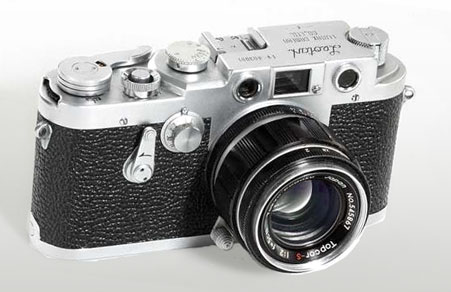
A Leotax FV of 1959 with a Topcor 50mm f2.0 lens
Leotax introduced the Leotax FV in August 1958. This was the first Leotax with a lever advance. It was introduced at the same time as the Canon VI-L which had the features of the Leotax FV plus a new, non-rotating shutter speed dial with all speeds on a single dial. The Leotax FV continued to have a split shutter with the slow shutter speed having a dial lock. Fast speeds extended to 1/1000 second.
This was also the first Leotax with a folding rewind crank. It also added a small window in the lever advance as a frame counter.

In less than 2 years, the Leotax FV sold about 2,500 units, primarily with the Topcor 50mm f2.0 as shown in the photograph above. With these features and combined rangefinder/viewfinder with enlarged eyepiece and viewing, this Leotax was in important improvement versus previous models.
The Leotax Model T 2L and Leotax Merit
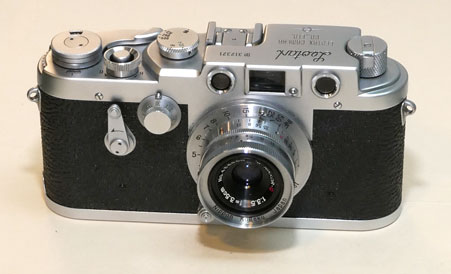
my Leotax T 2L of 1959 with the Nikkor 3.5cm f3.5 lens
Leotax introduced the Leotax Model T 2L in April 1959. 5 It featured a lever film advance and shutter speeds to 1/500 second, split at 1/30. The slow speed dial was with a lock, covering speeds 1-30, and the high speed extended to 1/500 second. Flash synchronization for electronic strobe was via a coaxial connection on the camera back. It was without a self-timer. However, the contemporaneous "Merit" version of the Leotax T 2L was identical, except furnished with a self-timer.
Leotax G
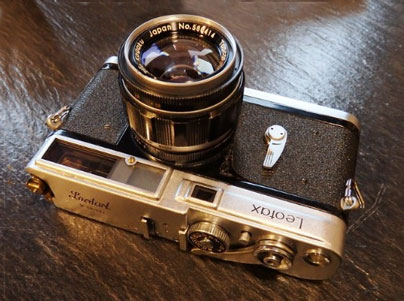
The Leotax G was Leotax's last camera. Only 500 pieces were sold, not enough to save the company from bankruptcy. It was again a camera in Leica style, but not just a Leica copy: Its body was almost like that of a Leica M3, but its viewfinder was like that of a Nikon SP, and it had an M39 screw mount intead of a bayonet-mount such as with the Leica Me.
You can click on the links in the table below to consult other pages of the canonrangfinder.org site.
| Navigation: Click Below to Jump to Desired Subject Page | ||
|---|---|---|
| Canon Rangefinder Cameras - 1 | Canon Rangefinder Cameras - 2 | Canon Rangefinder Lenses |
| Canon Hansa | Canon IIAF, IIAX | Development Nikkor 50mm |
| Canon S | Canon IVSB2 | Canon 19mm |
| Canon J | Canon IIS2, IID2, IIF2 | Canon 25mm |
| Canon NS | Canon VT, Canon L2 | Canon 28mm |
| Canon JS | Canon L1, L3 | Canon 35mm |
| Canon S-I | Canon VT Deluxe | Canon 50mm |
| Canon J-II | Canon VL, VL2 | Canon 85mm |
| Canon S-II | Canon VI-L, VI-T | Canon 100mm |
| Canon IIB | Canon P | Canon 135mm |
| Canon III, IIC, IV | Canon 7 | Canon 200mm-1000mm |
| Canon IIIA, IVF, IVS | Canon 7s | Canon Accessories |
| Canon IIA, IID, IID1 | Nicca Rangefinders | Canon Finders |
| Canon IVSB | Minolta Rangefinders | Minolta Lenses |
| Canon IIF, IIS | Other Rangefinders | other M39 lenses |
| Go to canonrangefinder.com home page | ||
Any additions or corrections to these pages would be welcome simply by contacting this site as shown at the foot of this page .
Footnotes:
1 Dechert, Peter. Canon Rangefinder Cameras 1933-1968. Hove Collectors Books. West Sussex, United Kingdom. 1985. ISBN 0-906447-30-5.
Peter Dechert's book is the most important expert source of information regarding Canon Rangefinder Cameras.
2 Kitchingman, Peter. Canon M39 Rangefinder Lenses 1939-1971. A Collector's Guide. Published by Peter Kitchingman. Perth, Australia. 2008. ISBN 978-0-646-48144-9.
Peter Kitchingman's book is the definitive study of the more than three decades of M39 format camera lenses developed for Canon Rangefinder Cameras.
3 Nostalgic Canon Camera Book. 懐かしいキヤノン EI Publishing Co. Ltd. Tokyo, Japan. June 2003.
Peter Kitchingman's book is the definitive study of the more than three decades of M39 format camera lenses developed for Canon Rangefinder Cameras.
4 "Canon Camera Museum" history website. https://global.canon/en/c-museum/history/ published by Canon, Inc. accessed in 2019.
5 Rajner, Hans P. (author), John Wade (editor). Leica Copies. Classic Collections Publications. London, UK. ISBN 13: 9781874485056
Hans P. Rajner's book is an excellently detailed and carefully researched study of camera from around the world which used the Leica M39 lens mount and the same lens to film plane distance.
7 Dechert, Peter. Canon Single Lens Reflex Cameras 1959-1991. Historical Camera Publications. Yakima, Washington. 1992. ISBN 1-879561-04-2.
8 Tomlinson, Shawn M. The Film Photography Book. Lulu Pulbications. 2016. ISBN: 9781365263972
9 Sartorius., Ghester. Identifying Leica Lenses. Classic Camera 19. Tokyo, Japan. 2001. ISBN 4-257-12029-0
10 website http://www.nicovandijk.net/rflensmatrix.htm consulted 2019.
11 O'Reagan, Douglas M. Allied Exploitation of German Science after World War II. Johns Hopkins University Press. Baltimore, Maryland. 2019. ISBN 9781421428888
12 website www.canonrangefinder.servehttp.com consulted 2008.
13 Minolta expert Andrea Aprà has posted information on minoltarangefinders group and other groups and further detailed information by email. (thanks Andrea !)
14 website http://www.collection-appareils.fr/objectifs/ consulted 2019.
15 Small, Marc James. Non-Leitz Leica Thread-Mount Lenses. Wittig Books. Hückelhoven, Germany. 1997. ISBN 3-930359-47-2.
16 the Nikon Corporation website: https://imaging.nikon.com/history/ consulted 2019.
17 p 152. Ray, Sidney F. Photographic Lens ISBN 9780240510323
18 website http://www.rokkorfiles.com/Lens%20History.html accessed 2019
19 Katz, Jerome. The Kardon camera story: a dedication to Peter Kardon, great American patriot & pioneer. SJF Enterprises. New York, New York. 1977.
20 Baird, John. The Japaneese Camera. The History of the Japanese Camera Monograph Collection. Historical Camera Publications. Yakima, Washington. 1990. ISBN 1-879561-02-6.
21 interesting website http://www.topgabacho.jp/Topconclub/Leotax.htm accessed 2019
22 Alexander, Jeffrey Scott. Nikon and the sponsorship of Japan's optical industry by the Imperial Japanese Navy 1923-1945. MA Thesis. University of British Columbia. 2001.
23 Alexander, Jeffrey Scott. Nikon and the sponsorship of Japan's optical industry by the Imperial Japanese Navy 1923-1945. PhD Thesis. University of British Columbia. 2010.
24 Lewis, Gordon, editor. Fujimura, Amy and Fujimura, William, translators. The History of the Japanese Camera. International Museum of Photography at George Eastman House. Tokyo and Rochester. 1991. ISBN 0-935398-17-1.
If you have any comments or questions about this Canon Rangefinder site, please e-mail me (Larry Huffman) at e-mail address: [email protected]